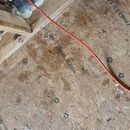Help with Touch-n-Seal closed-cell spray foam
Hello,
I recently purchased and sprayed (2) Touch N Seal closed cell spray foam kits on the underside of a vaulted ceiling roof deck in a recently constructed sunroom/addition. Most of the spray foam cured nicely but there are some spots that feel soft and several spots that appear to be oily and dripping brown liquid. I suspect that the mixture of the two chemicals was incorrect as I got to the end of the tanks. (I am not a professional installer).
Can anyone help with this? I am mostly concerned about the health risks of incorrectly mixed chemicals, odors, and off-gassing. Not sure how to proceed. I have included an up close picture of the foam and a picture of the dripped-on floor.
Thanks,
Bill
GBA Detail Library
A collection of one thousand construction details organized by climate and house part











Replies
Spots that are still soft or sticky after a few days should be removed and resprayed. This will be a sticky mess to do, so be sure to wear a tyvek suit while doing the work. You do NOT want the gooey stuff on your skin as it is very difficult to clean off (acetone helps).
I wouldn’t worry about a few drops on the floor, just clean them up as best you can. Clean any drops on the ceiling too.
The key to using these kits is to keep the tanks warm (typically 80-90F seems to work well) while spraying. If the tanks cool off too much, you’ll have problems. You need to do the first bit of spraying into a box or bag until the mix is right, and AS SOON AS the stuff starts to sputter near the end of the tank, stop using it immediately. There is always a bit of poorly mixed product in the first few seconds of use and near the end when the tanks start to run out.
Bill
Yep, and I've found that the DIY guns don't always spray exactly the right mix. There always seems to be more of one component than the other at the end. Unfortunately, the right approach is to tear out the bad stuff and try again. Now is the only chance you've got to get it right. If it stinks later, it is a lot harder to fix.
Thanks for the replies. Toward the end of the installation, the mix didn't seem right. It came out of the gun slowly and I tried to get the last bits out of the tanks. A few spots I sprayed actually had dissolved when I returned an hour later. The temperature of the tanks seemed ok (temp outside was mid 80's and humid.)
I sprayed this project about 10 days ago. Is it too late to avoid a long-term smell by scraping and reapplying?
Also, I am a bit worried about the off-gassing over time. I found myself reading horror stories of people having to evacuate their homes due to a failed application. That seems a bit extreme in my situation but again I am not a professional sprayer (you would know if you saw the mess I made from overspray.) If I do scrape off and reapply, do you think I will have long term problems?
thanks
It’s never too late to remove bad foam and reapply. The new spray foam will tend to seal any little bits you miss too, which is also a good thing.
Yes, there are some horror stories, but they’re rare. Remember that people who have good experiences are much mess likely to write lengthy posts about them than people who have bad experiences, which can skew your perspective. There are many people who have had good luck with those kits too, you just need to pay attention while working and be careful and you can get a good application too.
Bill
You have to get the uncured stuff out of there, easy now, much more work if it starts smelling down the road. Do your best to clean up any liquid, the little that is left will typically react with the new SPF and cure.
I would also remove the questionable soft foam.
When you spray with the new kit, keep an eye on the tanks, you should never let them run out and they should get used at about the same rate. Sometimes a clogged nozzle will throw off the mix, so make sure to change tips each time you stop. These are cheap and new clean tips avoid a lot of issues. Have some acetone and rag hand to wipe the gun each time you change the tips.
Any recommendations for the liquid that dripped onto the subfloor? It is stained in there pretty good. Will it cause long term problems if I clean it up and leave it be?
If I scrape the soft spots, respray, and clean up the wet spots, should I allow it to air out for a few weeks before putting the floor down and closing in the ceiling?
thanks
Scrape up what you can with a putty knife that you plan to trash when you're done with it. Scrub whats left with some course sandpaper if you want to be extra cautious. Whatever staining is left is probably not a problem. If you want to be extra super careful, you could use a good primer/sealer to encapsulate anything remaining on the subfloor. The final flooring material will cover things so the visual staining shouldn't be a problem.
Bill